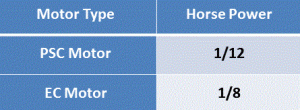CUSTOMER: Full Service Hotel
LOCATION: Philadelphia, PA
INDUSTRY: Hospitality
AIRREVIVE SERVICE: Fan coil unit refurbishment and re-commissioning

CUSTOMER: Full Service Hotel
LOCATION: Philadelphia, PA
INDUSTRY: Hospitality
AIRREVIVE SERVICE: Fan coil unit refurbishment and re-commissioning
UNIT SPECIFICATIONS:
Make: IEC
Model: 4CH315
Configuration: Horizontal

The process was the following:
Compare the same hotel guest room fan coil unit’s performance under 3 different conditions:
A. Fan coil unit with PSC motor and uncleaned coil.
B. Electronically commutated motor (EC Motor) retrofit into the unit with uncleaned coil.
C. EC motor retrofit after coil was rejuvenated. i.e. an AirRevive rejuvenated coil.
The energy savings are twofold:
1) In the differential in the RPM, which is visible.
2) In the reduced resistance, which is the lowered torque. This is essentially invisible but is manifest in the reduced energy consumption numbers.
The EC motors are torque sensitive. The EC motor on the dirty coil required a higher RPM to get the motor to perform according to its program, i.e. 1580 RPMs. The motor worked harder to overcome the dirty coil. To maintain constant RPM, the EC motor senses the resistance and automatically increases torque. The EC motor adjusts torque to maintain constant velocity. This increases power consumption.
The clean coil requires 30% less RPM to produce the same 450 CFM airflow i.e. 1220 RPM. Additionally, the motor draws less torque because the clean coil has less resistance. The motor does not have to work as hard.
Rejuvenating the coil is the best practice to retrofit an EC motor. This study shows that retrofitting EC motors into fan coil units with AirRevive refurbished unit with rejuvenated coils result in reduced energy consumption.